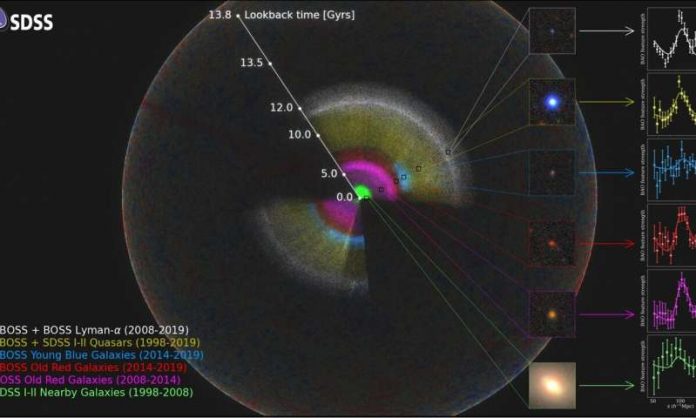The Sloan Digital Sky Survey (SDSS) released today a comprehensive analysis of the largest three-dimensional map of the Universe ever created, filling in the most significant gaps in our possible exploration of its history.
“We know both the ancient history of the Universe and its recent expansion history fairly well, but there’s a troublesome gap in the middle 11 billion years,” says cosmologist Kyle Dawson of the University of Utah, who leads the team announcing today’s results. “For five years, we have worked to fill in that gap, and we are using that information to provide some of the most substantial advances in cosmology in the last decade.”
The new results come from the extended Baryon Oscillation Spectroscopic Survey (eBOSS), an international collaboration of more than 100 astrophysicists that is one of the SDSS’s component surveys. At the heart of the new results are detailed measurements of more than two million galaxies and quasars covering 11 billion years of cosmic time.
We know what the Universe looked like in its infancy, thanks to the thousands of scientists from around the world who have measured the relative amounts of elements created soon after the Big Bang, and who have studied the Cosmic Microwave Background. We also know its expansion history over the last few billion years from galaxy maps and distance measurements, including those from previous phases of the SDSS.
“Taken together, detailed analyses of the eBOSS map and the earlier SDSS experiments have now provided the most accurate expansion history measurements over the widest-ever range of cosmic time,” says Will Percival of the University of Waterloo, eBOSS’s Survey Scientist. “These studies allow us to connect all these measurements into a complete story of the expansion of the Universe.”
The final map is shown in the image above. A close look at the map reveals the filaments and voids that define the structure in the Universe, starting from the time when the Universe was only about 300,000 years old. From this map, researchers measure patterns in the distribution of galaxies, which give several key parameters of our Universe to better than one percent accuracy. The signals of these patterns are shown in the insets in the image.
This map represents the combined effort of more than 20 years of mapping the Universe using the Sloan Foundation telescope. The cosmic history that has been revealed in this map shows that about six billion years ago, the expansion of the Universe began to accelerate, and has continued to get faster and faster ever since. This accelerated expansion seems to be due to a mysterious invisible component of the Universe called “dark energy,” consistent with Einstein’s General Theory of Relativity but extremely difficult to reconcile with our current understanding of particle physics.
Combining observations from eBOSS with studies of the Universe in its infancy reveals cracks in this picture of the Universe. In particular, the eBOSS team’s measurement of the current rate of expansion of the Universe (the “Hubble Constant”) is about 10 percent lower than the value found from distances to nearby galaxies. The high precision of the eBOSS data means that it is highly unlikely that this mismatch is due to chance, and the rich variety of eBOSS data gives us multiple independent ways to draw the same conclusion.
“Only with maps like ours can you actually say for sure that there is a mismatch in the Hubble Constant,” says Eva-Maria Mueller of the University of Oxford, who led the analysis to interpret the results from the full SDSS sample. “These newest maps from eBOSS show it more clearly than ever before.”
There is no broadly accepted explanation for this discrepancy in measured expansion rates, but one exciting possibility is that a previously-unknown form of matter or energy from the early Universe might have left a trace on our history.
In total, the eBOSS team made the results from more than 20 scientific papers public today. Those papers describe, in more than 500 pages, the team’s analyses of the latest eBOSS data, marking the completion of the key goals of the survey.
Within the eBOSS team, individual groups at Universities around the world focused on different aspects of the analysis. To create the part of the map dating back six billion years, the team used large, red galaxies. Farther out, they used younger, blue galaxies. Finally, to map the Universe eleven billion years in the past and more, they used quasars, which are bright galaxies lit up by material falling onto a central supermassive black hole. Each of these samples required careful analysis in order to remove contaminants, and reveal the patterns of the Universe.
“By combining SDSS data with additional data from the Cosmic Microwave Background, supernovae, and other programs, we can simultaneously measure many fundamental properties of the Universe,” says Mueller. “The SDSS data cover such a large swath of cosmic time that they provide the biggest advances of any probe to measure the geometrical curvature of the Universe, finding it to be flat. They also allow measurements of the local expansion rate to better than one percent.”
eBOSS, and SDSS more generally, leaves the puzzle of dark energy, and the mismatch of local and early Universe expansion rate, as a legacy to future projects. In the next decade, future surveys may resolve the conundrum, or perhaps, will reveal more surprises.
Meanwhile, with continued support from the Alfred P. Sloan Foundation and institutional members, the SDSS is nowhere near done with its mission to map the Universe. Karen Masters of Haverford College, Spokesperson for the current phase of SDSS, described her excitement about the next phase. “The Sloan Foundation Telescope and its near-twin at Las Campanas Observatory will continue to make astronomical discoveries mapping millions of stars and black holes as they change and evolve over cosmic time.” The SDSS team is busy building the hardware to start this new phase and is looking forward to the new discoveries of the next 20 years.





























